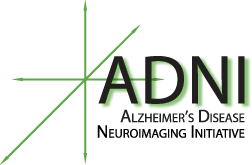Positron Emission Tomography (PET) image analysis was funded by ADNI for the following labs. Below is a summary of the PET analysis methods. Anyone with an ADNI Data Archive account may view and download the analysis methods and the analyzed data. After logging in, click “Download” and “Study Data” to see all relevant ADNI documents available for download.
Banner Alzheimer’s Institute
Co-investigator: Eric Reiman
The Banner Alzheimer’s Institute (Arizona) of the ADNI PET Core analyzes the FDG-PET data using the computer package SPM5 to examine the progression that correlates with changes in cognition and to evaluate cross-sectional differences among three diagnostic groups: patients with AD, patients with MCI and normal healthy controls. All PET from the post-processed group-4 images were downloaded from the ADNI data archive in NIFTI format.
- Summary of Statistical Parametric Mapping (SPM) Image Analysis
- SPM Methods, Results and SPM-based Global Indices
Jagust Lab, UC Berkeley
Co-investigator: William Jagust
Processed FDG Data Methods
A literature search on PubMed was conducted using permutations of six terms relating to FDG-PET, AD, and MCI in order to identify studies that carried out direct whole-brain contrasts of FDG data and reported Z-scores or T-values corresponding to MNI or Talairach coordinates that represented regions in which FDG uptake differed significantly between patients (AD or MCI) and controls. This resulted in a total of 15 studies involving a cross-sectional comparison of AD, MCI, and/or Normal groups and 178 MNI and Talairach coordinates. A spreadsheet of these coordinates, associated t-values or z-scores was created. Talairach coordinates were transformed into MNI space, and t-values were converted to z-scores, which were then mapped to the space of the MNI template brain as intensity values. There were 14 overlapping coordinates, and their z-scores were added. Resulting images were smoothed with a standard 14 mm FWHM kernel. The values of all voxels in the image were then normalized, resulting in an image with values between 0 and 1.
Processed Florbetapir (AV45) Data Methods
The Florbetapir methods description contains an explanation of the Freesurfer-based processing stream, and also a description of the methods used to derive our Florbetapir cutoff for this dataset. These processing methods were developed at Dr. William Jagust’s laboratory of the Helen Wills Neuroscience Institute, UC Berkeley and Lawrence Berkeley National Laboratory.
PET Facility, University of Pittsburgh
Co-investigator: Chester Mathis
An automated template-based method was used to sample multiple regions-of-interest (ROIs) on the ADNI PIB SUVR image. The PIB SUVR was downloaded from the ADNI website along with its corresponding ADNI Processed #3 MR image. The MR image choice was scanner dependent. The #4 PIB SUVR image has been co-registered to the first frame of the raw image file and averaged across frames (for dynamic acquisitions only), reoriented to Talairach space, intensity normalized so that the average of voxels within the mask was exactly 1, and smoothed to achieve a uniform isotropic resolution of 8 mm FWHM. Fourteen ROIs were generated.
SUVR Re-Normalized to CER
Results were compiled with the following data:
Subject ID, Group, Sex, Age, Study Date, Study UID, Series UID, Image UID, ACG (Anterior Cingulate), FRC (Frontal Cortex), LTC (Lateral Temporal Cortex), PAR (Parietal Cortex), PRC (Precuneus Cortex), MTC (Mesial Temporal Cortex), OCC (Occipital Cortex), OCP (Occipital Pole), PON (Pons), AVS (Anterior Ventral Striatum), CER (Cerebellum), SMC (Sensory Motor Cortex), SWM (Sub-cortical White Matter), THL (Thalmus)
Delineated ROIs
- AD Region of Interest PIB PET: Images of the scans with ROIs delineated. Related to Alzheimer’s disease (AD)
- MCI Region of Interest PIB PET: Images of the scans with ROIs delineated. Related to Mild Cognitive Impairment (MCI)
- Normal Subjects Region of Interest PIB PET: Images of the scans with ROIs delineated. Related to Normal Subjects (NL)
University of Utah Center for Alzheimer’s Care, Imaging and Research (CACIR)
Co-investigator: Norman L. Foster
The focus of The University of Utah component of the PET Imaging Core is on the individual image analysis and processing of molecular imaging data using 3-dimensional stereotactic surface projections (3D-SSP) computed by Neurostat, developed by Satoshi Minoshima [Minoshima et al., J Nucl Med 1995; 36:1238-48].
We have uploaded baseline ADNI1 FDG-PET images warped into Talairach space in dicom format. We have provided a document with 3D-SSP images of AD subjects showing a pattern of glucose hypometabolism that is consistent with frontotemporal dementia. We submit 6 numeric summary values that encapsulate information on the spatial extent and the severity of hypometabolism from FDG-PET and amyloid uptake values from amyloid-PET scans. We compute the averaged uptake values in 18F-FDG, 18F-AV45 and 11C-PIB images, for regions that are typically relevant to Alzheimer’s Disease: the frontal and association cortices. We also compute the differences of subjects compared to a control group by pixel-wise computation of Z-scores in Talairach space. For FDG scans, we submit the number of pixels significantly hypometabolic compared to a group of elderly normal subjects. These are normalized to pons. For amyloid scans, we submit the number of pixels with significant increased uptake compared to a group of amyloid negative subjects. These are normalized to cerebellum and total white matter. Our numeric summary value reporting the spatial extent of significant change counts the significant Z-scores. The numeric summary value that reports the severity of the deviations with spatial extent sums the significant Z-scores. For FDG scans, these values report the extent of hypometabolism, and for the amyloid scans, these values report the increase in tracer uptake.
Center for Brain Health, NYU School of Medicine
Mony J. de Leon
Hippocampal Glucose Metabolism Sampling, the NYU HIPMASK
We developed, validated, and published the HIPMASK technique for measurement of the HIP and other structures. HIPMASK generates a 3-D HIP sampling mask to accurately sample true HIP tissue with approximately 95% anatomical overlap between the HIPMASK and the co-registered MRI in normal elderly, MCI and AD groups.
Quality Control
- Every Florbetapir and FDG PET scan is reviewed for protocol compliance by the ADNI PET QC team
- If a correctable problem is identified, the PET QC team contacts the PET technologist directly
- If a problem with the scan is identified and it is not fixable, the PET QC team provides the PET technologist with protocol guidance to apply to future PET scans
Scans that fail the PET QC and are deemed unusable due to participant motion or non-compliance are documented with the reason as identified by the participant and the technician on the PET Scan Information Form. In these instances, rescans are only scheduled if the participant’s motion is believed to be correctable and is not a result of chronic illness or deteriorated cognitive ability.


